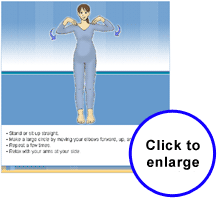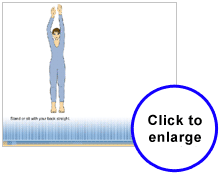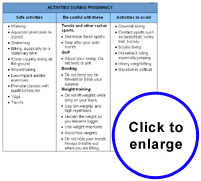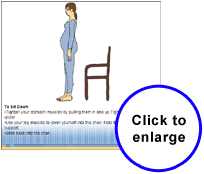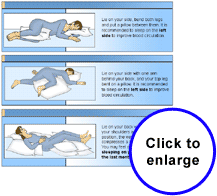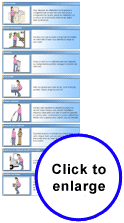MODULE 6
Healthy Activity
2. Elbow Circles
a. Warm-up
Warming up prepares your body for exercising. Slow stretching will make you more flexible and prepare your muscles for increased activity.
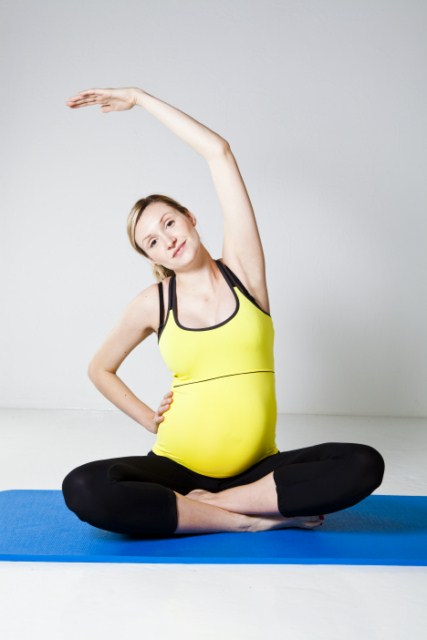
1. Alternate or Upward Arm Stretches
c. Safe and Comfortable Activities
Physical activity is not dangerous and is recommended during your pregnancy. By being careful, you can do most of the things you enjoy.
Walking, dancing, biking, gardening, pushing a baby in a stroller or playing with children are examples of daily physical activities that can improve your general health.
If you are already active, try to remain active during your pregnancy. If you were not physically active before your pregnancy, you could begin during your pregnancy by walking, swimming, and doing prenatal exercises.
Moderation is the key. Listen to your body. If you feel pain, fatigue, or are abnormally out of breath, slow down or change activity.
The following table contains a list of activities that are safe, activities that are less safe, and activities to avoid during pregnancy.
B. A PROGRAM FOR AN ACTIVE PREGNANCY
Prenatal activity strengthens, relaxes, and increases the flexibility of your body muscles. All of these are important for a healthy pregnancy and delivery and a quick recovery.
These exercises are also recommended after the birth of your baby. They will help you return to your pre-pregnancy state and give you the energy you need to enjoy your newborn.
These exercises should be done as often as possible - everyday is ideal. Have fun doing your exercises. A friend or your young children can join you to do the exercises. You will start to feel the benefits sooner than you might think.
Here are a few tips to practice safe physical activities
CAUTION: After cardiovascular exercise, do not lie flat on your back or on your right side until your body has cooled down.
 |
Stop exercising and talk with your doctor if
|
4. Changing Positions
As your baby grows during pregnancy, you may find it harder to change positions - for example, to get out of bed or to get up after exercising. Try to move slowly and carefully as you change position to help prevent muscle strain and dizziness.
The following animation demonstrates how to get out of bed.
The following animation demonstrates how to get up.
The following animation demonstrates how to sit in a chair and get back up.
3. Sitting Position
A rocking chair or good armchair will make sitting more comfortable.
The seat must be at the proper height so that your thighs rest comfortably when your feet are flat on the floor. It should be deep enough to support the length of your thighs but shallow enough to let your upper and lower back rest against the back of the chair.
The back should be high enough to support your shoulders. It is even better if it can support your head.
The armrests should be at the right height so that you can rest your arms comfortably when you are sitting straight.
If you do not have a comfortable rocking chair or armchair, you can make any chair more comfortable by using a pillow, footrests, or footstools for support.
Here are a few tips to adopt a good sitting position.
2. Sleeping Position
While pregnant, you may have difficulty finding a comfortable position to sleep. Unfortunately, your regular positions may not be suitable.
It is best to avoid lying on your back after you are 16 weeks pregnant. The best position for sleeping during pregnancy is on your side, especially if you sleep on your left side because this position improves blood circulation.
Your mattress should be firm. Sleep in a way that does not put strain on your neck and back muscles. You may change position while you are sleeping.
Here are a few tips to sleep comfortably.
Avoid sleeping on your belly because it puts too much pressure on your neck and back.
1. Housework
Housework should be shared with the family members. If not already done, ask your partner or other family members to do their share daily. It is very important to take care of you at this time. Accept the help offered now and after the birth of the baby.
The following pictures offer advice which may help to prevent daily back pain.
a. Posture
The key to comfort during your pregnancy is good posture. By standing correctly, you distribute the weight of your pregnancy without straining your back and abdominal muscles.
The following picture shows how you can improve your posture during your pregnancy.
Remember good posture when walking
Keep your back straight and your head up. Imagine that there is a rope attached to the top of your head, pulling you upward and straightening your spine.
Tips for comfortable standing
If you must stand for long periods, raise one foot on a stool or the rung of a chair. This will ease the tension on your back. When using a broom or vacuum, stand with one foot forward and knees bent. This will make it easier for you to shift your weight and turn.


